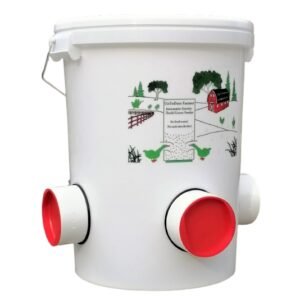Aflatoxin Poisoning is a mycotoxicosis (toxin produced by fungi) caused by metabolites produced by Aspergillus species. These fungi produce toxic secondary metabolites called aflatoxins, which can severely impact waterfowl health and production.
SYMPTOMS
CAUSES
PREVENTION
TREATMENT
Symptoms
- Acute Manifestations:
- Sudden death without prior clinical signs
- Lethargy and depression
- Reduced feed intake
- Impaired balance and coordination
- Yellow-tinged droppings
- Bruising and hemorrhages
- Chronic Manifestations:
- Reduced growth rate
- Decreased egg production
- Poor feed conversion
- Compromised immune function
- Weight loss
- Pale or jaundiced mucous membranes
- Liver enlargement and damage
Causes and modes of transmission
- Primary Causes:
- Consumption of contaminated feed
- Improper storage conditions of feed ingredients
- High moisture content (>14%) in feeds
- Temperature conditions favorable for fungal growth (25-35°C)
- Environmental Factors:
- High humidity (>85%)
- Poor ventilation in storage areas
- Damaged grains
- Insect infestation in stored feed
- Transmission Routes:
- Primary route through ingestion of contaminated feed
- Can be passed through eggs to offspring
- Contaminated bedding material
- Cross-contamination during feed processing
Prevention strategies
- Feed Management:
- Regular testing of feed ingredients
- Proper moisture control (<14%)
- Use of certified mycotoxin-free feed
- Implementation of HACCP protocols
- Storage Conditions:
- Maintain proper ventilation
- Regular cleaning and sanitization
- Temperature and humidity monitoring
- Pest control programs
- Management Practices:
- Regular feed rotation
- Use of mycotoxin binders
- Quality control measures
- Regular equipment cleaning
- Employee training on feed handling
Treatment options
- Immediate Actions:
- Remove contaminated feed immediately
- Provide fresh, clean water
- Isolate affected birds
- Supportive Care:
- Administration of vitamin supplements
- Liver protectants
- Electrolyte therapy
- Immune system boosters
- Specific Treatments:
- Use of mycotoxin binders (activated charcoal, bentonite)
- Hepatoprotective agents
- Antioxidant supplementation
- Probiotics to support gut health
- Long-term Management:
- Regular health monitoring
- Dietary adjustments
- Implementation of prevention protocols
- Documentation and record-keeping
Conclusion:
Aflatoxicosis represents a significant threat to waterfowl health and production. Success in managing this condition relies heavily on prevention through proper feed management and storage practices. When cases occur, prompt identification and appropriate treatment are essential for minimizing losses. Regular monitoring and maintenance of prevention protocols are key to long-term success in controlling aflatoxicosis in waterfowl operations.


